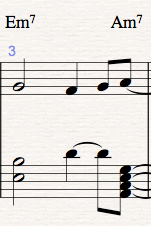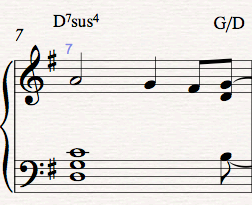
This melody happens to be in the key of G major, because that's how I heard it in my head before writing it down, but the key doesn't matter too much (the song can always be transposed after it's written), as long as you are familiar with the notes and chords of whatever key you've decided to use.
The first step I take when composing harmony is to find chords that give my song the "flavor" I'm looking for. In this case I wanted a dissonant "cool jazz" kind of sound, so I employed minor 7th and major 7th chords whenever possible. There's no right answer when it comes to finding chords, but it helps to have a knowledge of the different chords available in the key you are writing in and its related keys (I'll talk more about related keys when I discuss the Circle of 5ths in a future article). For me the process of finding the right chords is largely experimental. I play different chords until I find a progression that I like, and then I write them down. Here are the chords I came up with for this song:

After writing down the chords I added a blank bass clef line to the melody in my music arranging program (Sibelius) and printed a copy so I could begin composing the exact notes for the harmony. During this step I changed a few chords that didn't quite fit the sound I was looking for, and I looked for ways to make the harmony more interesting. Here is the rough draft of my arrangement:

And here is the "final" version in Sibelius:

Good composition involves the creative use of contrasts: consonance and dissonance, loud and soft, major and minor, movement and rest, richness ("close harmony") and sparseness. I'm going to go through the song measure by measure and discuss some of the techniques I used while writing the harmony.
In the 1st measure I used simple block chords in the root position, and they exactly matched the chords I came up with when I roughed-in the harmony. The term "with pedal" is my lazy way of saying that the musician should use the pedal in a manner of his or her choosing throughout the song:

Measure 2 includes two "fill" notes. Since the melody is at rest for 4 counts, I added these notes to keep the songs moving and to add interest and variety:

In measure 3 I rearranged the Em7 chord, initially playing only the 1st and 5th tones and then adding the minor 7th tone on the 3rd beat (and dropping the 3rd tone). The Am7 chord is played in the root position:

Measure 4 originally had a "fill" note in the melody, but as I was doing the arranging I decided to remove that note and let the D chord, played half way through the measure, take its place:

Measure 5 uses an Em chord (instead of the Em7 I had originally written) in its 1st inversion. I modified the Am7 chord to an Am/G chord (an A minor chord with a G note in the bass):

Measure 6 is similar to measure 3. The 1st and 7th tones of the Fmaj7 chord are played initially, the 5th tone is dropped and the 3rd tone is played half way through the measure. The Fmaj7 chord is "foreign" to the key of G major, borrowed from the closely related key of C major, and it gives this part of the harmony a slightly exotic sound:

The D7sus4 chord in measure 7 is arranged without the 5th tone, which would be an A if it were present:

Measure 8 provides a contrasting resting point for the song, both harmonically and rhythmically. The song's "bridge" -- measures 9 through 12 -- begins with a pickup note at the end of the measure:

In measure 9 the D7 chord is split into two parts. Initially only the 3rd, 5th and 7th tones are played, then half way through the measure the 1st (or root) tone is played, completing the aural puzzle. The harmony in this measure is written in two voices so that the first notes that are played continue through the entire measure. The D note that is added half way through the measure adds richness to the notes already being played, but doesn't take their place:

In measure 10 the Em chord again appears in its 1st inversion. I just realized that this would be impossible to play as it's written. The measure starts with whole notes, and then the three eights notes (which echo the melody) are supposed to be played while the whole notes are still being held down. Most humans don't have enough fingers on their left hands to be able to pull that off, so I'll need to make an adjustment there. The song is still a work in progress, and I'll continue to play it and make minor modifications for the next few weeks before declaring it "finished":

In measure 11 the Am7 chord is split up and inverted. The first part of the chord is played in its 2nd inversion, without the 3rd tone. Then the 3rd tone (a C note) is played in the second half of the measure:

The 12th measure doesn't actually contain a Gmaj7 chord, because I liked the sound of an A note in the base instead of G. The second half of the measure contains a Bm chord, which is the top three notes of a Gmaj7 chord. This chord should be written as Bm/A, but a Gmaj7 chord fits the song, too:

Since the melody in measure 13 is the same as in measure 1, I could have just copied the same harmony from measure 1. But I wanted to add interest and variety, so I thinned out the harmony a bit by only playing a B note and a G note in the first half of the measure (the 5th and 1st tones of an Em chord). I kept the Dm7 chord in block format, as it was in the first measure, but this time I dropped the third tone:

The 14th measure contains a split Cmaj7 chord. The 1st, 3rd and 7th tones are played initially, then half way through the measure the 5th tone is played (as a "fill" note):

The 15th measure uses an Em chord in its 2nd inversion. The bass note, B, is held throughout the measure while the top notes of the chord change to Bm (in the last beat of the measure). It was tempting to end the song on a D7 to G chord progression, but the dominant 7th to root chord cadence is so cliché that I wanted to do something a little different:

The song ends on a G/D chord (a G chord in its 2nd inversion). This is a bit unusual, because songs usually end with a slightly more resolved feeling by placing the final chord in its first inversion, but ending with a 2nd inversion seems to work for this song:

Over the next few weeks I'll revise this song, adding the metronome mark (95 beats per minute), adding dynamics, and continuing to make minor changes and tweaks until I'm satisfied or until I get so tired of changing it that I just have to call it "finished."
I also need to consider the playability of the song (how easy or difficult it is for pianists to play). I could arrange it in a way that makes it easy for beginning pianists, and this might require changing the key so that there are fewer ledger lines in the left hand. Or I could add more grace notes and trills and larger finger spreads to make it sound more rich and full (but also making it more difficult to play). I could also add more right hand notes, since the right hand currently just contains the melody line in all but a few cases. I could expand the song, since it's only 16 measures long, or I could add variety and interest by repeating the same measures but in different octaves. If I wanted to add lyrics, I could write a piano accompaniment for the song. Then I could publish it, record it, set it aside, or do whatever I want to do with it. The nice thing about being a composer by hobby rather than profession is that I can work on songs when I want to and I am free to be as creative as I would like. The process of composing can be time-consuming and difficult at times, but it can also be quite fulfilling. When a new song is finally "finished" I always feel a sense of accomplishment and satisfaction.